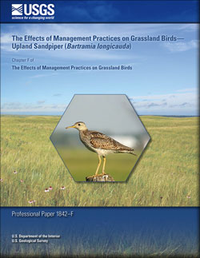The Effects of Management Practices on Grassland Birds—Upland Sandpiper (Bartramia longicauda)
Links
- Document: Report (2.19 MB pdf)
- Larger Work: This publication is Chapter F of The effects of management practices on grassland birds
- Download citation as: RIS | Dublin Core
Abstract
The key to Upland Sandpiper (Bartramia longicauda) management is providing grasslands of various heights with few shrubs. In general, Upland Sandpipers forage within short vegetation and nest and rear broods within taller vegetation. Upland Sandpipers have been reported to use habitats with less than (<) 93 centimeters (cm) vegetation height, 5–75 cm visual obstruction reading, greater than or equal to 33 percent grass cover, less than or equal to (≤) 50 percent forb cover, ≤13 percent shrub cover, 3–12 percent bare ground, 11–30 percent litter cover, and <13 cm litter depth.
Suggested Citation
Shaffer, J.A., Igl, L.D., Johnson, D.H., Dinkins, M.F., Goldade, C.M., Parkin, B.D., and Euliss, B.R., 2019, The effects of management practices on grassland birds—Upland Sandpiper (Bartramia longicauda), chap. F of Johnson, D.H., Igl, L.D., Shaffer, J.A., and DeLong, J.P., eds., The effects of management practices on grassland birds: U.S. Geological Survey Professional Paper 1842, 20 p., https://doi.org/10.3133/pp1842F.
ISSN: 2330-7102 (online)
Table of Contents
- Acknowledgments
- Capsule Statement
- Breeding Range
- Suitable Habitat
- Area Requirements and Landscape Associations
- Brood Parasitism by Cowbirds and Other Species
- Breeding-Season Phenology and Site Fidelity
- Species’ Response to Management
- Management Recommendations from the Literature
- References
| Publication type | Report |
|---|---|
| Publication Subtype | USGS Numbered Series |
| Title | The effects of management practices on grassland birds—Upland Sandpiper (Bartramia longicauda) |
| Series title | Professional Paper |
| Series number | 1842 |
| Chapter | F |
| DOI | 10.3133/pp1842F |
| Publication Date | September 06, 2019 |
| Year Published | 2019 |
| Language | English |
| Publisher | U.S. Geological Survey |
| Publisher location | Reston, VA |
| Contributing office(s) | Northern Prairie Wildlife Research Center |
| Description | iv, 20 p. |
| Online Only (Y/N) | Y |
| Additional Online Files (Y/N) | N |


